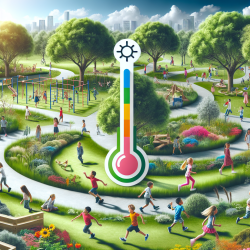Introduction
In an era where urbanization and climate change are reshaping our environments, the importance of integrating nature into our daily lives cannot be overstated. The Green Schoolyards Project, as explored in the research article "Effects of trees, gardens, and nature trails on heat index and child health: design and methods of the Green Schoolyards Project," provides a compelling case for how green spaces in school environments can positively impact child health and well-being.
The Power of Green Schoolyards
The Green Schoolyards Project was designed to assess how green features—such as trees, gardens, and nature trails—affect the heat index and the physical activity levels of children, particularly those from low-income Latinx families. The study's findings reveal that these natural elements can significantly mitigate the effects of urban heat islands and promote healthier lifestyles for children.
Key Findings and Implications
One of the standout findings of the project is the role of trees in reducing the heat index. The study observed that areas with heavy tree canopy exhibited significantly lower heat indices compared to unshaded areas. This reduction in temperature not only makes outdoor spaces more comfortable but also encourages children to engage in physical activities, which are crucial for their physical and mental development.
Moreover, the study found that children naturally gravitate towards shaded areas during high heat periods, highlighting the intuitive human response to seek comfort in nature. This behavior underscores the potential of green schoolyards to serve as safe havens where children can play, learn, and grow.
Practical Applications for Practitioners
For practitioners looking to implement these findings, the Green Schoolyards Project offers a blueprint for designing school environments that foster health and wellness. Here are some actionable steps:
- Incorporate More Trees: Planting trees in strategic locations can significantly lower temperatures and create inviting spaces for children to play.
- Develop Nature Trails: Nature trails can provide children with opportunities to explore and connect with their environment, enhancing their social-emotional learning.
- Engage the Community: Involve local communities in the maintenance and use of these green spaces to ensure sustainability and maximize their benefits.
Encouraging Further Research
While the Green Schoolyards Project provides valuable insights, it also opens the door for further research. Practitioners are encouraged to explore how different types of vegetation and landscape designs can further enhance the benefits observed in this study. Additionally, understanding the long-term impacts of green schoolyards on academic performance and social behavior could provide a more comprehensive picture of their value.
Conclusion
As we face the challenges of climate change and urbanization, the integration of nature into our educational environments becomes increasingly vital. The Green Schoolyards Project demonstrates that with thoughtful design and community involvement, we can create spaces that not only mitigate environmental challenges but also promote the health and well-being of our children.
To read the original research paper, please follow this link: Effects of trees, gardens, and nature trails on heat index and child health: design and methods of the Green Schoolyards Project.










